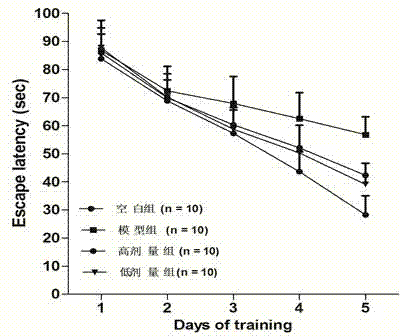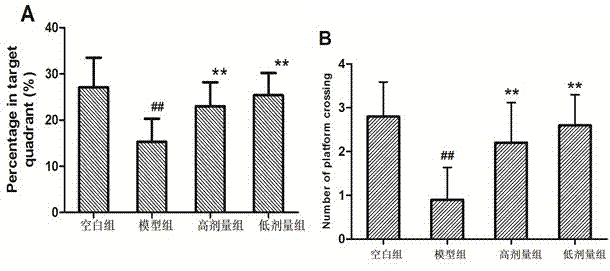Transcription factor system as well as preparation method and application thereof
A technology of transcription factor and construction method, applied in the application field of Alzheimer's disease gene therapy, can solve the problems of difficult to achieve in vivo application, insufficient recombinant virus titer, unsatisfactory packaging cells, etc., and achieve spatial learning. The effect of improving memory ability, improving spatial learning and memory ability, and reducing adverse reactions
- Summary
- Abstract
- Description
- Claims
- Application Information
AI Technical Summary
Problems solved by technology
Method used
Image
Examples
Embodiment 1
[0028] Example 1: Construction of recombinant lentiviral expression vectors of three neuron regeneration-related transcription factors Ascl1, Brn2, Pax6 According to the synthesis of DNA fragments of target genes Ascl1, Brn2, Pax6: According to human Ascl1 (Genbank accession number: NM_008553), Brn2 (Genbank accession number: NM_008899), Pax6 (Genbank accession number: NM_008899) gene sequence, design the target gene primer, its sequence is as follows:
[0029] (1) Ascl1: 5’-caagagcgcagccttag-3’; 3’-gcaaaagtcagtgctgaacg-5’.
[0030] (2) Brn2: 5’-aataaggcaaaaggaaagcaact-3’; 3’-caaaacatcattacctgct-5’;
[0031] (3) Pax6: 5’-gccagcaacacacctagtca-3’; 3’-ggggaaatgagtcctgttga-5’.
[0032] A gene fragment containing the DNA sequence of the target genes of the transcription factors Ascl1, Brn2, Pax6 was purchased from the human cDNA library (Shanghai Yingji Biotechnology Co., Ltd.), and the target genes of Ascl1, Brn2, and Pax6 were amplified by PCR. PCR product (PCR kit purchased from Takara...
Embodiment 2
[0036] Example 2: Recombinant plasmid lentivirus packaging
[0037] 1. Virus packaging steps
[0038] The lentiviral expression vector was constructed according to the method introduced by Zhou et al. (Zhou Letal., 2010). The recombinant lentiviral plasmid pGC-L-GFP-Ascl1, pGC-L-GFP-Brn2, pGC-L-GFP-Pax6 and the lentiviral packaging plasmid pHelper1.0 (Invitrogen, cat.No. 11668-500) and pHelper2.0 (Invitrogen, cat. No. 11668-500) were co-transfected with 293T cells. After 72 hours, the supernatant was collected and the growth medium was added at the same time. After 12 hours, the supernatant was collected again to obtain three recombinant lentiviral particles LV-Ascl1, LV-Brn2, and LV-Pax6.
[0039] 2. Specific steps for virus harvesting and concentration
[0040] Centrifuge the supernatant obtained in step 1 at 4000g for 10 minutes at 4°C to remove cell debris, and filter the supernatant through a 0.45um filter membrane in a 40ml ultracentrifuge tube; add the crude virus extract sam...
Embodiment 3
[0043] Example 3: Application of three transcription factor recombinant lentiviral particles in Alzheimer's disease gene therapy
[0044] Select 40 adult male C57BL6 mice and randomly divide them into four groups, set as blank control group, Alzheimer's disease model group, high-dose virus treatment group, low-dose virus treatment group, model group mice and treatment group. Aβ1-42 (purchased from -) was stereotactically injected into both hippocampus of mice, and the blank control group was given sterile saline. Three days before Aβ1-42 was modeled, the three recombinant lentiviral particles LV-Ascl1, LV-Brn2, LV-Pax6 were mixed in a ratio of 1:1:1 (virus titer 1*10 8 TU / ml), 2ul of the mixed virus mixture was injected into the bilateral hippocampus of mice in the treatment group through a stereotactic injection device. The blank control group and the model group were given the same dose of sterile saline and lentiviral LV-GFP as controls. .
[0045] One week after the treatment ...
PUM
 Login to View More
Login to View More Abstract
Description
Claims
Application Information
 Login to View More
Login to View More - R&D
- Intellectual Property
- Life Sciences
- Materials
- Tech Scout
- Unparalleled Data Quality
- Higher Quality Content
- 60% Fewer Hallucinations
Browse by: Latest US Patents, China's latest patents, Technical Efficacy Thesaurus, Application Domain, Technology Topic, Popular Technical Reports.
© 2025 PatSnap. All rights reserved.Legal|Privacy policy|Modern Slavery Act Transparency Statement|Sitemap|About US| Contact US: help@patsnap.com


